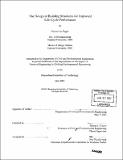| dc.contributor.advisor | Jerome J. Connor. | en_US |
| dc.contributor.author | Flager, Forest Lee, 1978- | en_US |
| dc.contributor.other | Massachusetts Institute of Technology. Dept. of Civil and Environmental Engineering. | en_US |
| dc.date.accessioned | 2006-03-24T16:01:33Z | |
| dc.date.available | 2006-03-24T16:01:33Z | |
| dc.date.copyright | 2003 | en_US |
| dc.date.issued | 2003 | en_US |
| dc.identifier.uri | http://hdl.handle.net/1721.1/29552 | |
| dc.description | Thesis (M.Eng.)--Massachusetts Institute of Technology, Dept. of Civil and Environmental Engineering, 2003. | en_US |
| dc.description | Includes bibliographical references (leaf 44). | en_US |
| dc.description.abstract | Current structural design practice is primarily concerned with optimizing the construction cost and schedule of a building project, while ensuring that the structure meets basic safety and serviceability requirements. The maintenance costs, alteration/replacement costs, and end-of-life costs associated with the support of the structure after the initial construction process is given far less consideration. Initial research indicates that, for a typical building, the majority of the cost over the system life cycle is incurred after the original structure has been completed. The ultimate value and longevity of a building is, therefore, largely dependant on the ability of the structure to be economically maintained and easily modified during its service life. The objective of this paper is to outline a design process that considers how buildings interact with time. The process involves two fundamental steps: (1) the modularization of the structure to accommodate how different parts of the building change over time and (2) the design of modular components in consideration of their expected service life. Life cycle cost methods are applied to evaluate the performance of design alternatives-thus making it easier to explicitly consider the cost associated with how a structure will be supported and may be adapted over time, in addition to the customary tasks of calculating construction costs and schedules. Despite the apparent benefits to this approach, there are a number of obstacles preventing the adoption of life cycle design principles into professional practice. Specific obstacles to implementation are discussed with respect to the construction industries in both the United States and Japan. The paper concludes with the description of further case study research to be conducted in the Japan during the summer of 2003, the findings of which will be published as an addendum to this document. | en_US |
| dc.description.statementofresponsibility | by Forest Lee Flager. | en_US |
| dc.format.extent | 44 leaves | en_US |
| dc.format.extent | 2650594 bytes | |
| dc.format.extent | 2650402 bytes | |
| dc.format.mimetype | application/pdf | |
| dc.format.mimetype | application/pdf | |
| dc.language.iso | eng | en_US |
| dc.publisher | Massachusetts Institute of Technology | en_US |
| dc.rights | M.I.T. theses are protected by copyright. They may be viewed from this source for any purpose, but reproduction or distribution in any format is prohibited without written permission. See provided URL for inquiries about permission. | en_US |
| dc.rights.uri | http://dspace.mit.edu/handle/1721.1/7582 | |
| dc.subject | Civil and Environmental Engineering. | en_US |
| dc.title | The design of building structures for improved life-cycle performance | en_US |
| dc.type | Thesis | en_US |
| dc.description.degree | M.Eng. | en_US |
| dc.contributor.department | Massachusetts Institute of Technology. Department of Civil and Environmental Engineering | |
| dc.identifier.oclc | 52723360 | en_US |
